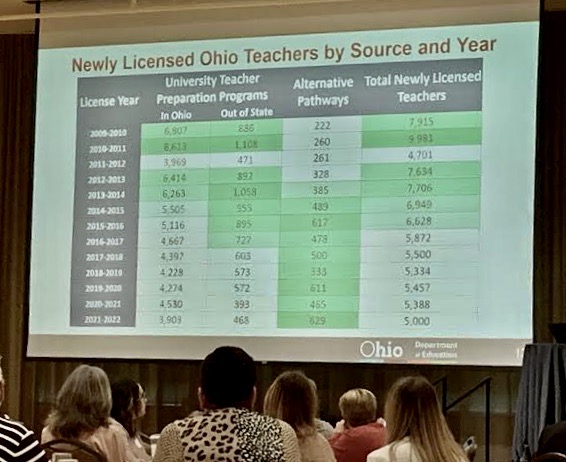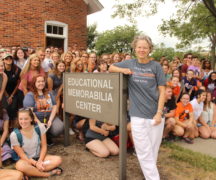By JULIE CARLE
BG Independent News
Ohio is experiencing a teacher shortage.
In 2010-11, the state had 9,981 newly licensed teachers. By 2021-22, the number dropped by nearly half to 5,000. Additionally, the number of Ohio college students studying to become teachers fell from nearly 30,000 in 2010 to 13,700 in 2017.
Hundreds of education professionals, community leaders and current university education students, all who have a reason to be concerned about the shortage, gathered Friday at Bowling Green State University for the Northwest Ohio Teacher Shortage Summit. The event was the last of five regional summits throughout the state.
They met to hear some of the factors driving the shortage and to address the challenges to ensure there are enough teachers in Ohio’s classrooms.
The decline of highly qualified teachers is a complicated issue that involves both recruitment and retention of individuals, said Julie McIntosh, dean of the College of Education at the University of Findlay.
Beyond the impact the pandemic had on teachers and students, individuals are going to other school districts or leaving teaching altogether because of low compensation, school and/or district culture, physical conditions of the buildings, lack of growth potential and professional development opportunities, and workplace inflexibility.
Recruiting students into the field also faces challenges, from the costs of becoming a teacher and regulations regarding the required state licenses to a general lack of respect for the profession.
Ohio is not alone in the crisis. Teacher shortages are a national epidemic. According toa national study, the U.S. has lost 567,000 teachers since the pandemic.
According to Ohio Higher Education Chancellor Randy Gardner, the state has provided $5.2 million in teacher shortage grants to 30 universities across the state to increase the number of candidates admitted to and completing educator licensure programs and address shortages of educators across the state.
“We are looking to find innovative ways to attract young people into the field,” he said.
Programs such as “Grow Your Own” encourages school districts to mentor and encourage its own students to pursue careers as teachers. The support continues in the college years with the goal of students graduating and returning to their home schools to teach.
Alternative pathways to licensure, such as 2+2 programs for community college students, and easier pathways to accommodate paraprofessionals who want to become fulltime teachers and military personnel who want to transition into teaching, hold great potential, he added.
“It’s too early to know how it’s going, but we are hoping for feedback on these programs and other ideas. We want your ideas,” Gardner said.
Dawn Shinew, dean of the BGSU College of Education and Human Development, said the college is already offering programs that can address some of the issues related to the teacher shortage, “We started an alternative resident educator program that is all online, recognizing that not everyone can get to campus.”
It is the first completely online, competency-based alternative resident educator program in Ohio. Teachers can complete alternative licensure requirements on their own time in their content area.
BGSU also collaborates with several school districts in Ohio to create teacher pipelines that benefit students and school districts.
Not every school district has been impacted by teacher shortages yet, but they need to be prepared, said Carolyn Everidge-Frey, interim senior executive director at the Ohio Department of Education.
“The lack of qualified candidates to fill vacancies in our schools jeopardizes our students’ education. It’s vital that we stay connected, work together to gather the data and share the resources to identify strategies that will provide a continuous, healthy pipeline for future teachers in Ohio while at the same time ensuring the teachers who are entering the classrooms choose to stay there,” Everidge-Frey said.
“It’s all about making sure we are serving students and families and the best way to do that is to make sure we address the challenges of teachers in our classrooms,” Gardner said.
During the roundtable discussions at the summit, participants shared ideas for consideration. Among those suggestions were: open pathways for students to return to their home schools to train and substitute, create a network portal where college students who might not have direct connections to schools can upload their portfolios, and make use of positive student stories to counteract negative social media.
The Ohio Department of Education and the Ohio Department of Higher Education will continue to collect important data and review the input from all five of the regional summits that could lead to plans for future legislation.
Additionally, conversations to address the teacher shortage will continue locally, regionally and across the state.
“There is no magic answer today, but it’s a really important conversation,” Gardner said. “The takeaway here is that we want to welcome people with passion and talent to the teaching profession. At the end of the day, I still think teaching is a profession that matters.”




